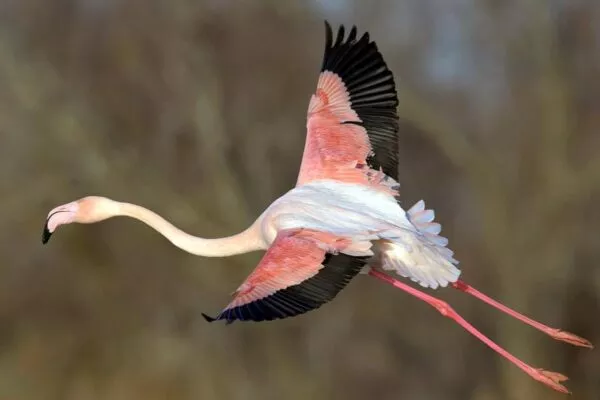Ducks are members of the Anatidae family, which is made up of 43 genera and around 174 species. Known for their huge beaks, webbed feet, and wide, sturdy bodies, ducks are easily recognizable and a regular sight all around the globe. Given that they’re most famous for their antics on the sea, it seems sensible to inquire about their migration.
Even though they are mostly found near bodies of water, many ducks are excellent fliers and may travel great distances in the winter. One such species that migrates all the way to South Africa and India from its breeding sites in Northern and Central Europe is the garganey duck. It has been observed that during the winter, mallards in North America move more than 700 miles (1,100 km) south.
In actuality, ducks are self-assured in the air, water, and land! Certain animals, like the Shelduck, are able to soar to heights of 17,000 feet, when the ambient temperature is well below -15°C. Even while ducks are normally better suited to their colder environments, many of them nonetheless choose to migrate throughout the winter to warmer locations.
Continue reading to find out more about the different ducks’ migratory habits!
Ducks migrate when?
Ducks migrate in North America and Northern and Central Europe in the late summer, usually in September, but they may go as late as October in mild winter years. In the Palearctic and Siberia, duck migration may begin as early as August.
Although March or May is more typical, most ducks return to their nesting areas as early as April. However, it does depend on the season; during an exceptionally mild winter, certain ducks, such as Mallards, may decide not to migrate at all.

Do ducks travel in large numbers?
In the upper Northern Hemisphere, a large number of duck species are at least partly migratory, departing from their breeding areas toward the end of the summer and returning at the onset of spring. Some people choose not to move at all and choose to stay citizens of their host nations.
One such duck species that may or may not migrate is the mallard. While not all Mallards from North America or Britain migrate, those that do often depart in September and go to the Middle East, the Mediterranean, the Southern United States, or Central America. Remarkably, the elegant Mandarin duck does not leave the United Kingdom either, considering how many of its more resilient relatives do!
The majority of Wigeons migrate. The Eurasian Wigeon, which leaves its chilly breeding areas in Scandinavia and Siberia, travels widely over Central Europe during the summer, with many of them ending up as far south as East, West, and Central Africa. Another North European duck that migrates south for the winter is the Eurasian teal, some of which end up considerably farther south than others.
Numerous pintail ducks are also skilled fliers and powerful migratory; one Northern Pintail is said to have flown 1,864 miles (1,864 kilometers) nonstop throughout its migration. Many go to Asia, South Africa, Sub-Saharan Africa, and Japan, while other Russians settle in China and Japan.
The Shoveller duck, which includes the Northern Shoveller, is another migratory bird; its European and North American populations travel to Africa and South Asia, respectively, and to Central and South America.
The Garganey is perhaps the most common duck that migrates. Many ducks only migrate in part, but the Garganey is a particularly vigorous migrant; almost the whole population of Europe and the Palearctic migrates thousands of kilometers to South Africa in India.
Ducks are adaptable birds, and their migratory patterns reflect this adaptability. They usually don’t need to move as far as they do since the majority can withstand the cold fairly well. It’s possible that migration is more a question of desire than survival.
Ducks move to where?
Ducks in the Northern Hemisphere often migrate from Central and Northern Europe to Africa and the Middle-East (teals and wigeons) or the Mediterranean (mallards, for example). Some, like the Garganey, take flights all the way to South Africa.
Pochards and long-tailed ducks, which are found in Siberia and the Palearctic, are examples of ducks that may travel as far north as Central and Western Europe.
Some ducks, notably mallards, migrate only a few hundred kilometers southward during the winter in North America, which includes both the US and Canada. In the winter, mergansers usually migrate southwest. Like several Whistling ducks, some North American teals have been known to spend the winter in Central and South America.

Do ducks move a long way?
The majority of ducks travel just as far as it takes them to obtain food and warmer roosting areas. If they migrate at all, it may only take them a few hundred kilometers in many situations. For instance, some ducks are dispersed over Scandinavia, and the subarctic wind up in Scotland—not exactly a sunny getaway!
Mallards are among the longer-distance flyers; they can soar for up to 800 miles (1287 km) nonstop. During the breeding season, northern pintails travel about 5,000 kilometers to reach the equator from much of northern Europe and the Palearctic!
Why don’t some ducks migrate?
Similar to several other migrating species, ducks are not always fully dedicated to their trip. They only move if circumstances demand it, mostly because doing so will keep them out of the cold and prevent food shortages.
Given that they can fly, ducks may easily get a free vacation in Africa, Asia, South America, or the Mediterranean region! Even though a large number of ducks are suited to cold climates, they nonetheless choose to migrate. Ducks may migrate out of desire rather than need since they like spending their time in the sun, where there is plenty of food and shelter.
How do ducks spend the winter months?
Depending on the species and area, ducks could migrate in the winter or not. When ducks are happy in their surroundings, they will often select a warm spot to sleep close to a lake, river, or seashore. Other ducks will just go to the inside, where it is slightly warmer and more protected.
In search of milder climates in South and Central America, Asia, Africa, and Southern Europe, migratory ducks often move south during the winter.
Can ducks endure the cold months?
Ducks are quite resilient and have evolved well to the cold in many species. Their rich fat and thick, water-repellent down help keep them warm in the winter. Even the duck down is coated with an insulating oil to help keep them watertight.
The Long-tailed duck, as well as the Spectacled, King, Stellers, and Common Eider ducks, are among the duck species that inhabit the Arctic and Palearctic areas. These are some of the world’s hardiest birds.
Do ducks return to the same spot each year?
Ducks attempt to return to the same locations every year due to a strong affection for their breeding grounds. Although ducks aren’t well-known for having a good sense of direction or being adept navigators, they are quite good at interpreting clues that lead them home after the winter.
Ducks establish deep social relationships with their flock, with whom they often move, even though the majority of them are not monogamous. Every year, breeding flocks often return to the same breeding areas.
Do ducks migrate in the UK?
Throughout the year, over 22 different species of ducks visit the UK. While some of these ducks are migrants or immigrants, the most of them are locals who spend the whole year here.
One such duck that may migrate to Southern Europe and the Mediterranean, or it may stay in the UK, is the well-known Mallard. Other Mallards come from overseas on UK soil. The Tufted duck is a non-migratory bird that lives mostly in the United Kingdom. Wintering in the UK includes wigeons, gadwalls, pintails, and certain teals; others may go south to Africa and the Middle East.
Do ducks go southward during migration?
Ducks often move southward when they do so. It becomes hotter the closer they travel to the equator. Nevertheless, migration is also influenced by food choice and abundance in addition to temperature.
Ducks travel northward when?
Ducks only migrate north when they are moving from a coastal zone that is more southerly to an inland area that is slightly more northerly, where the climate is still warmer and there is more food available. After winter, which may come as early as March, ducks migrate northward.
Do ducks use flight to migrate?
It is true that ducks travel via air. Even though most people only see them swimming in bodies of water or waddling on land, many ducks are skilled long-distance fliers.
Many duck species travel at high elevations of several thousand feet during their migration, when the air temperature may dip as low as -20C!
Ducks travel long distances without stopping to rest. For example, mallards are reported to migrate for up to 800 miles nonstop. In actuality, a large number of waterfowl and members of the Anatidae family are very powerful fliers with exceptional endurance for extended distances.






